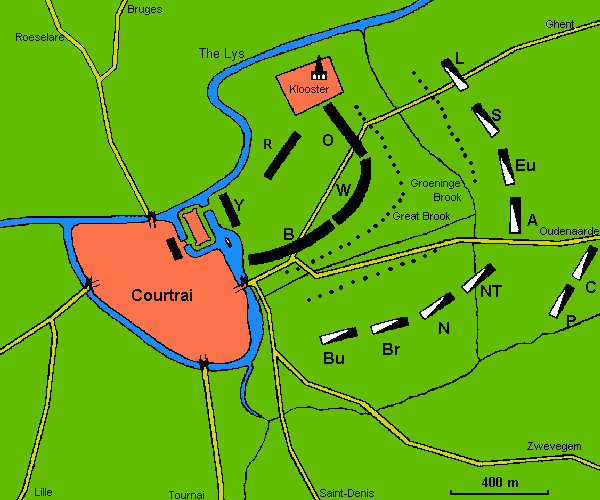Battle of the Golden Spurs, also called Battle Of Courtrai (July 11, 1302). Was a military engagement on the outskirts of Kortrijk in Flanders (now in Belgium) in which an untrained Flemish infantry militia, consisting mainly of members of the craft guilds (notably that of the weavers) defeated a professional force of French and patrician Flemish cavalry, thus checking the growth of French control over the area. It is so named for the spurs supposedly taken from the vanquished. The towns of Flanders rebelled against the occupying French army and besieged the French garrison at Courtrai castle. France then sent a relief army. The militia prevailed over the mounted force by making its stand on a patch of ground surrounded by streams and moats, thus frustrating any attempt at a rapid cavalry charge; the marshy terrain also impeded other efforts of the horsemen. This victory led to a generation of political ascendancy of the weavers’ guild in the urban centres and ended the threat of French annexation. It also began the “infantry revolution” of the 14th century. The Scots, at the Battle of Bannockburn (1314), consciously emulated the Flemings, and their victory led the English to fight on foot—and win—against the French at the Battle of Crécy (1346) and the Battle of Poitiers (1356).

The battle
The combined Flemish forces met at Kortrijk on 26 June and laid siege to the castle, which housed a French garrison. As the siege was being laid, the Flemish leaders began preparing a nearby field for battle. The size of the French response was impressive, with 3,000 knights and 4,000–5,000 infantry being an accepted estimate. The Flemish failed to take the castle and the two forces clashed on 11 July in an open field near the city next to the Groeninge stream.
The field near Kortrijk was crossed by numerous ditches and streams dug by the Flemish as Philip's army assembled. Some drained from the river Leie or Lys, while others were concealed with dirt and branches, making it difficult for the French cavalry to charge the Flemish lines. The marshy ground also made the cavalry less efficient. The French sent servants to place wood in the streams, but they were attacked before they completed their task. The Flemish placed themselves in a strong defensive position, in deeply stacked lines forming a square. The rear sides of the square were covered by a curve of the river Leie. The front sides presented a wedge to the French army and were placed behind larger rivulets. The large French infantry force led the attack, which initially went well and managed to cross the rivulets. Subsequently however, they failed to force back the Flemish front rows. The French commander Robert of Artois became impatient and recalled his foot soldiers to free the way to the noble cavalry. The cavalry were much hindered by the streams and ditches which the infantry had more easily negotiated in the beginning of the battle, and the disciplined Flemish infantry held firm. Unable at most points to break the Flemish line of pikemen, many French knights were knocked from their horses and killed with the goedendag, the spike of which was designed to penetrate the spaces between armour segments. Those cavalry groups that succeeded in breaking through were set upon by the reserve lines, surrounded and wiped out. To turn the tide of the battle de Artois ordered his cavalry reserves to continue the charges, with the same lack of success. When ultimately the French knights became aware that they could no longer be reinforced, their attacks faltered and they were gradually driven backwards into the rivulet marshes. There the disorganized, fallen, and mud-drowned French cavalry were an easy target for the heavily armed Flemish infantry. A desperate charge from the French garrison in the besieged castle was thwarted by a Flemish contingent specifically placed there for that task. The French infantry was visibly shaken by the sight of their knights being slaughtered and withdrew from the rivulets. The Flemish front ranks then charged forward, routing their opponents who were massacred. The surviving French fled, only to be pursued over 10 km by the Flemish.
Unusually for the period, the Flemish infantry took few if any of the French knights prisoner, in revenge for the French "cruelty". Robert of Artois was surrounded and killed on the field. According to some tales he begged for his life but the Flemish refused, claiming that they did not understand French.
The goedendag Polearm, weapon of the Flemish militia:

